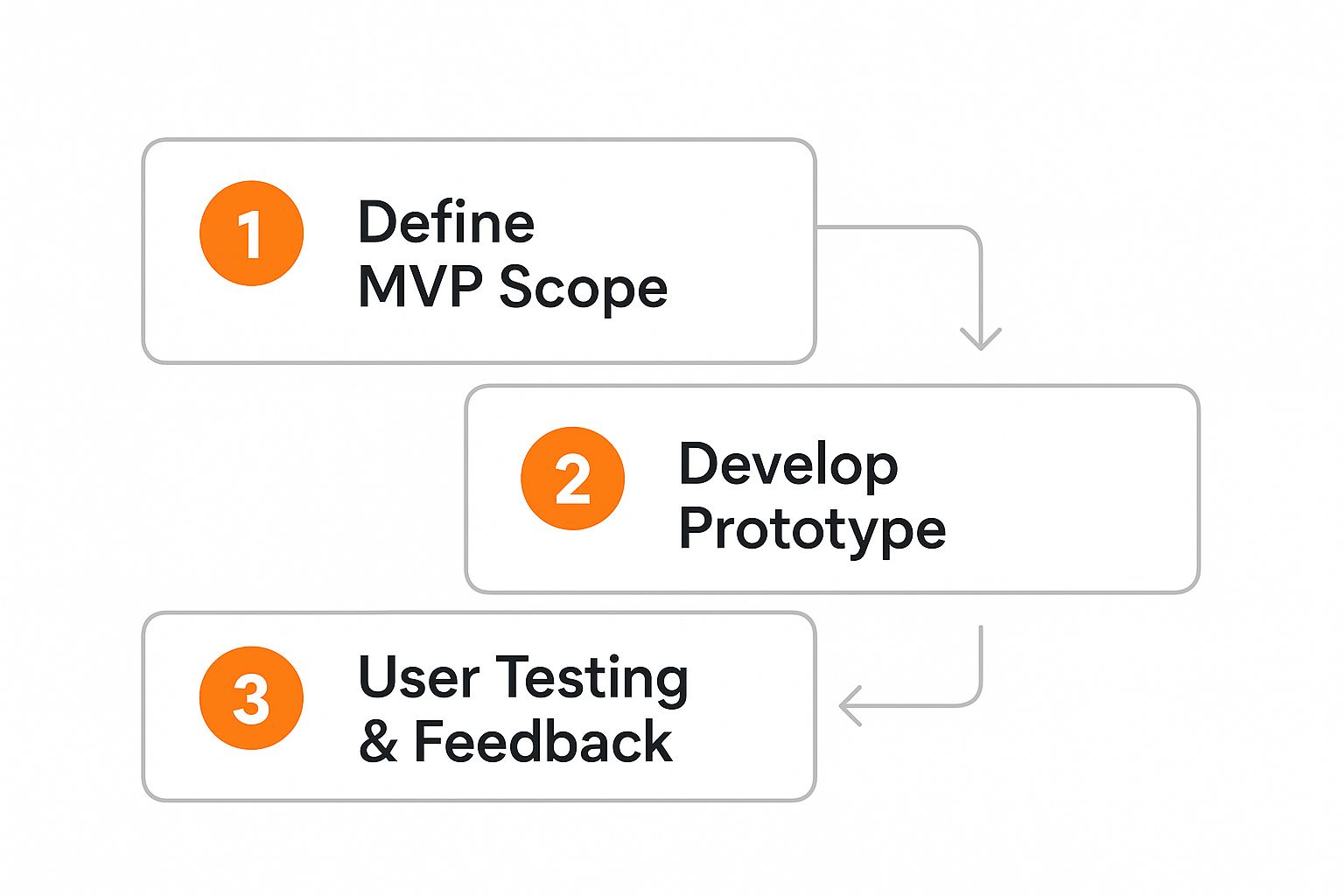So, you have a business idea. That's the easy part. The hard part is figuring out if it's actually any good—and by "good," I mean something real people will actually pay for. This is where validation comes in. It's the structured, sometimes-uncomfortable process of testing your concept against reality before you sink your life savings and countless hours into it.
It’s about moving from "I think this is a great idea" to "I have evidence that people will pay for this."
Why Most Startups Fail and How Validation Can Save Yours
Every founder starts with a spark of passion. It’s easy to get lost in the dream of building something amazing, a product or service that changes everything. But that same passion can create a massive blind spot. Too many founders build in isolation, convinced they're creating the next big thing, only to launch to absolute silence.
Let's be blunt: a brilliant idea means nothing without customers. The number one killer of startups isn't a buggy product or a weak team; it’s a lack of market need. They build a beautiful solution to a problem that nobody has. Rigorous, honest validation is the only vaccine for this.
The startup graveyard is full of good intentions. The statistics are sobering: about 90% of startups ultimately fail, and a brutal 70% of those go under between their second and fifth years. If you want to dig deeper into these numbers, you can find out more about why validation is a non-negotiable step.
Think of Validation as Your Strategic Compass
I see founders, especially indie hackers and solo entrepreneurs, skip this step all the time. The reasons are almost always the same:
- The "I just know" syndrome: You're so in love with your idea that you feel market research is just a waste of time.
- Fear of rejection: You're terrified that if you ask for feedback, people will say "no," and that will crush your motivation.
- The builder's itch: You're a maker. You want to code, design, and build. Talking to people feels like a distraction.
Here's the reframe: validation isn't a roadblock; it's a compass. It’s not there to shoot down your vision. It's there to strengthen it by pointing you directly toward what customers actually want and are willing to open their wallets for.
Treat validation as an insurance policy for your most precious assets: your time, your energy, and your money.
Learning to validate your business idea properly isn't a chore; it’s your single biggest competitive advantage. It's what separates the founders who build things they hope people want from those who build things they know people need. Getting this mindset right from the start is the first, and most important, step you can take toward building a business that lasts.
Finding Problems People Are Desperate to Solve
Every great business starts with a problem, not a clever solution dreamed up in a vacuum. Before you can even think about validating an idea, you have to find a problem that people are genuinely desperate to solve. The best ideas aren't born in isolated brainstorming sessions; they're discovered by listening to real people talk about their frustrations.
Too many founders fall into the trap of building a solution and then desperately searching for a problem it can fix. That’s a recipe for failure. A much more effective path is to become an expert at finding problems first. Immerse yourself in the communities where your potential customers are already gathered and complaining.
Uncovering Pain Points in Online Communities
If you want to find raw, unfiltered demand, look no further than online forums and communities. These are the modern-day town squares where people go to vent, ask for help, and share their janky workarounds for things that drive them crazy. This is the language of real need.
As you read through these discussions, keep an eye out for a few key signals:
- Recurring Questions: Are people asking the same things over and over? That’s a clear sign of a widespread, unsolved issue.
- Expressions of Frustration: Pay close attention to phrases like, "I wish there was a tool for..." or "Does anyone know how to..." These are practically open invitations to build something.
- DIY Solutions: When you see someone proudly sharing a monstrous spreadsheet or a clunky process involving five different tools, you've just found a gap in the market.
Reddit is a goldmine for this kind of research, especially for indie hackers and solopreneurs. Subreddits like r/SaaS, r/indiehackers, and r/solopreneurs are packed with builders and business owners who aren't shy about sharing their daily struggles.
The real secret is to listen before you start building. The most valuable business ideas are often hiding in plain sight, disguised as simple complaints in a forum thread. By paying attention, you can spot the needs that everyone else is overlooking. For a deeper dive, check out our guide on identifying customer needs.
A Smarter Way to Find Startup Problems
Of course, manually digging through thousands of Reddit posts is a massive time sink. This is where having the right tool can give you a serious edge. We built ProblemSifter specifically for this—to cut through the noise and deliver a curated list of validated problems directly to you.
Here’s a glimpse of the kind of actionable insight you can pull from a ProblemSifter report.

As you can see, the tool doesn’t just offer up a vague idea; it pinpoints a specific pain point from an actual conversation.
Unlike other tools, ProblemSifter doesn’t just suggest ideas—it connects you to the exact Reddit users asking for them. It gives you the problem, the original post, and the usernames of the people who expressed that exact pain point. This is incredibly powerful. You get a validated idea and your first list of potential customers to interview, all in one go.
This approach doesn't just save you countless hours. It ensures you're building something people have already confirmed they want. For just $49, you can get lifetime access to a curated list of real startup problems people are discussing in a subreddit of your choice ($99 for three). No subscriptions, no hidden fees—just a straightforward, high-impact investment for any founder serious about solving a problem that matters.
Conducting Customer Interviews That Get Real Answers

Alright, you’ve pinpointed a problem. The next move is crucial: talking to the people who are actually living with it. This is where so many founders stumble. They go into conversations fishing for compliments, asking questions that practically beg for a polite, "That sounds like a great idea!"
But here's the hard truth: compliments don't build a business. You're not looking for encouragement; you're hunting for the unvarnished truth.
To get to that truth, you have to shift your entire approach. Stop asking about hypotheticals. Instead, dig into people's past behavior and their current, real-world struggles. This is the whole idea behind "The Mom Test," a framework that's saved countless founders from the bias of well-meaning friends and family.
The core principle is brilliantly simple. Don't ask people if they would use your product. Ask them how they've already tried to solve the problem. Their answers will tell you everything you need to know about whether this is a genuine "hair-on-fire" issue or just a minor inconvenience they can live with.
Finding the Right People to Interview
Your insights are only as good as the people you source them from. It's not enough to talk to just anyone; you need to speak with individuals who are squarely in your target market and truly feel the pain you're trying to solve. This is precisely where a tool like ProblemSifter can be a game-changer.
Instead of just casting a wide net on social media and hoping for the best, ProblemSifter hands you a pre-vetted list of ideal interview candidates. It identifies the specific Reddit usernames of people who have already complained about a particular problem online. This gives you a direct line to your target audience, saving you immense time and ensuring the feedback you get is from a genuinely qualified source.
Key Takeaway: A great interview doesn't start with the first question. It starts with finding the right person—someone who has already demonstrated they have the problem you're trying to solve.
Crafting Questions That Reveal the Truth
The questions you ask are the tools you use to uncover a market need. You have to be careful not to lead the witness or hint at your solution. The entire conversation should revolve around their experience with the problem.
Here are a few examples of effective, open-ended questions grounded in The Mom Test framework:
- "Can you walk me through the last time you dealt with [the problem]?"
- "What have you already tried to do about this? And how did that work out for you?"
- "What's the hardest part of dealing with this?"
- "If you could wave a magic wand, what would your ideal solution do?"
Notice a pattern? These questions are all about past actions and specific details. This method uncovers real pain points, not just optimistic guesses about a future product. Focusing on lived experiences is how you truly understand the market need. This initial research is absolutely vital; a 2022 report revealed that 58% of founders whose startups failed wished they had done more market research from the get-go.
After just a handful of these conversations, you’ll start to see patterns emerge. You'll hear the same frustrations, the same failed workarounds, the same desired outcomes. These recurring themes are your validation signals, the proof that you're on the path to building something people will actually pay for. For a deeper dive into this process, check out our guide on conducting effective market research.
Testing Your Solution with Prototypes and MVPs
You've done the research and the interviews. You're confident you’ve found a real problem worth solving. Now comes the exciting part: seeing if your proposed solution actually works.
This is a critical juncture where many founders trip up. They fall into the trap of thinking they need a perfectly polished, feature-complete product to get started. The truth is, that’s a recipe for wasted time and money. Your real objective right now is simple: learn as much as you can, as quickly as you can, with the least amount of effort. This is the entire philosophy behind building a prototype or a Minimum Viable Product (MVP).
An MVP isn't a scaled-down, buggy version of your final product. Think of it as the most focused, streamlined version of your idea that delivers that one "aha!" moment of value to your very first users. It’s a learning tool, first and foremost, designed to get you concrete proof that people will use what you’re building before you sink months into development.
From Idea to Tangible Test
Creating an MVP doesn't always mean writing code. In fact, it often shouldn't. The trick is to pick the method that lets you test your most critical assumption in the fastest, most inexpensive way possible.
Here are a few proven, low-effort ways to do this:
- Landing Pages: Can you get people excited enough to sign up for something that doesn't even exist yet? A simple landing page explaining your value proposition with a clear call-to-action (like an email signup) is a powerful way to gauge real-world demand.
- Explainer Videos: Dropbox famously validated its entire concept with a simple demo video. It showed how file-syncing would work, went viral, and drove hundreds of thousands of signups before the product was fully built. That’s validation.
- Functional Prototypes: For some ideas, users need to click around and feel it. Tools like Figma or Balsamiq allow you to create surprisingly realistic, clickable prototypes. You can test user flows and gather feedback on the experience without a single line of code.
This isn’t just theory; it’s how successful companies are built. Dollar Shave Club launched with a hilarious viral video, validating its razor subscription model by generating an incredible 12,000 orders in just 48 hours. Early, scrappy tests like these are what separate businesses that last from ideas that fizzle out. For a deeper dive, you can explore how successful companies validate their ideas.
The flowchart below breaks down this iterative process, from defining your scope to gathering that all-important user feedback.

Notice how it’s a cycle. You test, you learn, and that feedback directly fuels the next, smarter version of your prototype.
Choosing Your Validation Method
Not sure which approach is right for you? It really depends on what you need to learn and the resources you have. This table breaks down some of the most common methods to help you decide.
| Validation Method | What It Validates | Cost & Effort | Best For |
|---|---|---|---|
| Landing Page | Market demand & value proposition resonance | Low | Testing interest for a new product or service before building anything |
| Explainer Video | Problem/solution understanding & emotional resonance | Low to Medium | Demonstrating a complex or novel concept in a simple, engaging way |
| Clickable Prototype | User experience, flow, and feature usability | Medium | Getting feedback on app/software design and core functionality |
| Concierge MVP | Willingness to pay & core solution effectiveness | High (Time) | High-touch services where you manually deliver the solution to early users |
| Functional MVP | Core functionality & initial user engagement | High (Time & Code) | When interaction with a working product is essential for validation |
Ultimately, the best method is the one that gets you the most reliable data, the fastest. Start small, test a single core assumption, and build from there.
Defining Your MVP's Core Feature
The single biggest challenge you'll face when building an MVP is feature creep. The temptation to add "just one more little thing" is immense. You have to be ruthless in resisting it.
Your MVP should do one thing exceptionally well: solve the most painful, critical problem you uncovered during your customer research.
An MVP is not about the minimum number of features; it's about the maximum amount of validated learning you can get for the least amount of effort.
Forget the bells and whistles. Focus exclusively on the core user journey that delivers on your primary promise. If you're building a meal-planning app, the MVP isn’t about social sharing or a fancy algorithm. It’s about one question: can a user successfully and easily create a basic meal plan? Everything else is noise.
The goal is to get your prototype into the hands of real people—perhaps some of the same folks you identified earlier with a tool like ProblemSifter—and just watch. Their actions will tell you far more than their words ever could, giving you the definitive validation you need to move forward with confidence.
Choosing the Right Tools for Idea Validation

Having a solid process is one thing, but the right tools can be a massive shortcut. We're talking about compressing what could be weeks of grinding manual effort into a few focused hours. For indie hackers and solopreneurs, this isn't a luxury—it's survival. Your time and your cash are your most precious resources, and you need to guard them fiercely.
Your validation toolkit doesn't need to be flashy or expensive. In my experience, the simplest tools are often the most effective because they get you answers with the least friction. Think landing page builders and survey software. The goal isn't to build a perfect tech stack; it's to test your core assumptions as quickly and cheaply as possible.
But here’s the critical part where so many founders stumble: they start testing a solution before they've even confirmed there's a problem. They get excited about an idea, throw up a landing page, and then wonder why nobody cares. You have to be dead certain you've found a painful, urgent need first.
From Vague Ideas to Actionable Insights
Manually digging through forums and social media for customer pain points is a miserable task. It's a slow, messy grind that leaves you with a jumble of disorganized notes. This is exactly where a purpose-built tool for problem discovery gives you a serious edge. It helps you validate the need before you even whisper the word solution.
Reddit, in particular, is a goldmine for this kind of research. It's one of the few places online where people are brutally honest about their frustrations and openly beg for help. A specialized tool can cut through the noise and pinpoint these moments for you.
A lot of tools will give you generic ideas. The real magic happens when a tool connects you directly to the specific people asking for a solution. That's when research transforms into a targeted list for validation and outreach.
The Power of Direct Connection with ProblemSifter
Most market research tools are built for corporate teams with big budgets. They'll give you high-level trend reports and market sizing, which is interesting but not actionable. They won't give you a list of names of people who need your product right now. ProblemSifter flips that model on its head, making it a must-have for any builder's toolkit.
Here’s why its approach gives you such a massive head start:
- Real, Unfiltered Problems: It scans discussions across specific subreddits to pull out genuine pain points that people are actively trying to solve. No fluff.
- Direct User Access: This is the key. It doesn't just show you the problem; it gives you the original Reddit post and the usernames of the people who expressed that pain. This is your first list of pre-qualified leads for customer interviews.
- Built for Outreach: You can use this intel to both shape your idea and promote your solution. Imagine messaging someone who complained about a problem last month with the exact tool they were desperate for.
This direct connection is a total game-changer. It takes all the guesswork out of how to find your target audience and gives you a clear path forward.
The pricing is also structured for builders, not big companies. You won't find any recurring subscriptions here. For just $49, you get lifetime access to a curated list of real startup problems from a single subreddit of your choice, or you can get three for $99. It's a small, one-time investment that pays for itself with a constant stream of validated ideas and potential first customers—a huge advantage when you're trying to validate a business idea on a tight budget.
Common Questions on Validating Your Business Idea
As you start the journey of validating your startup idea, you'll inevitably run into some recurring questions. I've seen founders get stuck on these time and again. Getting them sorted out early helps you focus on what actually matters: building something people will happily pay for.
How Much Validation Is Enough?
This is the big one, isn't it? The frustrating but honest answer is that there’s no magic number or finish line. Validation isn't a box you check; it’s a continuous process of de-risking your venture.
You're not aiming for 100% certainty—that’s a myth. What you're really looking for are strong signals that justify moving to the next stage. Are people eagerly giving you 30 minutes of their time for an interview? Are they handing over their email address on your landing page? The ultimate signal: are they willing to pre-pay for a solution that doesn’t even exist yet?
The Key Takeaway: Your goal isn't to eliminate all risk. That's impossible. It's about gathering enough concrete evidence to make your next big investment—whether that’s time or money—a calculated bet, not just a shot in the dark.
What If I Get Negative Feedback?
Let's be real, negative feedback can feel like a punch to the gut. But trust me, it’s one of the most valuable gifts you can receive at this stage.
Every "no," "I don't really get it," or "this isn't for me" is a piece of data that saves you from the catastrophic fate of building something nobody wants. It’s infinitely better to hear this during a casual interview than after sinking six months and your life savings into development.
The trick is to dig into the "why" behind the pushback. Resist the urge to get defensive. Instead, get curious. Try asking something like, "That's really helpful to know. Could you tell me a bit more about what part feels confusing or doesn't seem to fit?"
This kind of criticism is gold. Use it to sharpen your idea, tweak your messaging, or even reconsider your target audience entirely. More often than not, the most critical feedback holds the exact insight you need to pivot toward a much stronger business.
Can I Validate a B2B Idea the Same Way as a B2C One?
Yes and no. The fundamental principles are the same: find a painful problem, talk to the people experiencing it, and test a potential solution. That part doesn't change. However, the B2B world has its own unique complexities you can't ignore.
With B2B, you're almost always dealing with at least two distinct personas:
- The User: This is the person whose daily work will be directly impacted by your product. They care about usability, features, and how it makes their job less of a headache.
- The Economic Buyer: This is the manager, director, or executive who holds the budget and signs the checks. Their focus is on ROI, security, compliance, and how your tool integrates with their existing tech stack.
You absolutely have to validate your idea with both. A tool that users love but buyers can't justify is dead on arrival. A tool with a great business case that users hate will churn out in a month. Your interviews and MVP tests need to address the distinct needs and motivations of both these roles to have a real shot at success.
Ready to stop guessing and start finding real, validated problems? ProblemSifter turns Reddit into your personal startup idea engine, connecting you directly with the users and discussions that matter. Validate faster and build smarter at ProblemSifter.
